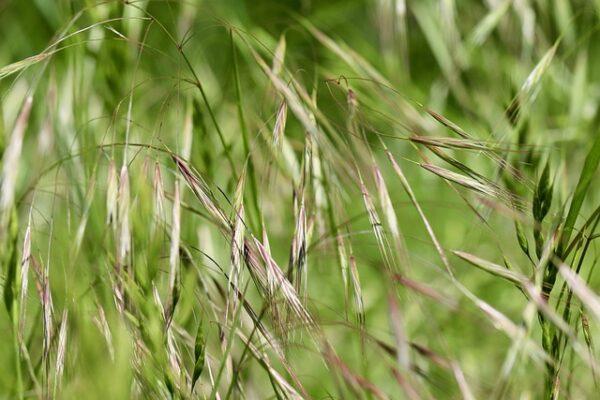
You're probably well aware of the various health issues and hazards that can pose a risk to your dog. You might also have heard about the dangers of grass awns, but do you know why they're dangerous?
Did you know that those idyllic fields of waving grain, as beautifully depicted in "America the Beautiful," can pose a severe risk to your dog's well-being? Yes, those innocent-looking plants hold the potential for grave health concerns.
Allow me to share a personal experience: Once, during our vacation, one of our dogs had a foxtail stuck in the corner of his eye. With no local vet clinics open, my resourceful mother got out her tweezers and had my brother hold our dog still. It took several minutes, but she grasped the foxtail deeply enough and pulled it out. Our little terrier was fine, if a bit put out over being so rudely man handled.
In this post we'll learn about the dangers of grass awns and how you can safeguard your dog. Join us to learn about this hidden peril.
Understanding grass awns
What are they?
Grass awns are the seed pods of tall grasses that grow throughout North America. Sounds harmless doesn't it?
Don't be fooled though. They can create serious health issues in dogs and other animals.

The problem is their bristle-like structure helps them stick to anything - such as your shoelaces or your dog's fur. They can also get into your dog's nose, eyes or other parts of his body. And backward-pointing bristles make them hard to pull out. Worse yet, when your dog moves those awns can inch forward because of the bristles. They can even penetrate the skin and migrate around inside your dog's body causing inflammation and infection.
Grasses that produce awns include:
- foxtails
- cheatgrass
- june grass
- timothy hay
- downy brome
- needle grass
- wild barley
- spear grass
- Canadian wild rye
- foxtail barley
- winter bentgrass / ticklegrass
Where and when are grass awns found?
Grasses, whether cultivated or wild, can have dangerous awns if they are unmowed and allowed to go to seed. Anywhere grass grows - in meadows, along trails or roads, and even in your yard - they pose a risk.
The grass itself is not dangerous. It's the seed pod - or awn - that can cause health issues.
When grasses produce their awns can vary by location and weather. Generally they go to seed during dry and warm seasons. That might be for a short time at mid-summer for northern locations. Or it could be year-round in the warm south-western areas.
Dangers of grass awns
Grass awns, with their bristles, can become entangled in your dog's coat when he runs through tall grass. Sometimes they're tangled so completely that they can't migrate. Although they can be hard to brush out, doing so can spare your dog pain and potential infection.
More likely the awns will move deeper into your dog's coat due to their arrowhead shape and backward-pointing bristles. If they're not removed they can pierce the skin and potentially migrate throughout his body.
If your dog hunts during the fall be sure to brush him thoroughly when you get home. Or run your fingers through his coat, feeling for awns or bumps which could be ticks.
Common places awns can lodge
The most common places these awns cause problems are between the toes, or in the eyes, ears, or nostrils. They've also pierced the gums or skin and have worked their way in through external genital organs.
Between Toes:
Grass awns can work their way between your dog's toes, leading to irritation and possible infection. This is especially true for dogs with long or thick fur.
Eyes:
Grass awns can get trapped in a tear duct or behind the eyelid. This can cause redness, swelling, discharge, or even scratches on the cornea.
Ears:
Because of the ear canal structure, grass awns can migrate deep within causing irritation, inflammation, and infections.
Nose:
Dogs experience the world through their noses, but that puts them in danger of inhaling grass awns. Sneezing and rubbing their nose or face is a warning sign. Sometimes these awns migrate into the respiratory system causing serious health problems.
Under the Skin:
Another one of the dangers of grass awns it that they can penetrate the skin and travel through the body's soft tissues.
Consequences of grass awn migration
After a day's hunt or even just a romp in a field, grass awns can cause irritation and discomfort. If they're not removed they can pierce the skin, introducing bacteria that can lead to an infection or abscess. An awn can migrate deeper into tissues and organs causing damage and potentially serious complications.
Sometimes the entrance wound heals and isn't noticed. However, weeks or even months later your dog could develop odd symptoms. Your veterinarian might run tests without being able to pinpoint the cause of the symptoms all because of a migrating awn. Depending on its migration route it could damage your dog's heart, lungs or even brain.
Treatment
When caught early, brushing or using tweezers works fine. However, if the awn is in a sensitive place or has punctured the skin, it's time to visit your veterinarian. In that case, your dog will probably need to be sedated and the area shaved to remove the awn.
If the awn migrated deep into your dog's body, your vet may use ultrasound to locate it and surgery to remove it. Sometimes the awn isn't seen, but rather the path it took.
Another sign to watch for is when your dog has an infection and does well initially on an antibiotic, but then the infection flares up again. This can happen if an awn isn't removed. Tell your vet if your dog has been in tall grass.
Prevention
Not all grasses produce awns, but it's better to take precautions just in case.
Suggestions to minimize the dangers of grass awns include:
- whenever possible, avoid fields with grass that have gone to seed during the summer and fall
- brush your dog immediately after running in an area that may contain grass awns
- use your fingers to feel through your dog's coat including the chest, armpits, belly, and groin areas
- visually inspect eyes, ears, gums, and between the toes
- consider trimming your dog's fur in places where awns are likely to collect
- consider outfitting your dog with boots and or goggles
Symptoms of an embedded grass awn include:
- non-healing wound
- areas of redness and swelling
- limping
- head shaking
- sneezing
- scratching ears or face
- discharge from eyes or nose
Summary
Grass awns, often known as foxtails or grass seeds, can cause lots of problems for your dog. Most of the problems happen in late summer and early fall just in time for hunting season.
You can avoid areas with tall grass, particularly when it's gone to seed. If you have a dog with long hair, especially on their feet, you can keep them trimmed. You can check your dog every time they've been in tall grass. Pay particular attention to their feet, nose, eyes, ears, armpits and groin.
Although prevention takes more effort, checking your dog can minimize the dangers of grass awns. If you find or even suspect a grass awn foreign body, contact your veterinarian as soon as possible. The quicker it is removed, the better the chance of a successful outcome.
NOTE: The information on this website is not intended to replace your veterinarian's advice. This information is intended to provide non-technical information in an easy-to-understand format. The website author accepts no responsibility or liability for how this information may be interpreted or construed, or any actions that might be taken as a result of the information herein.


